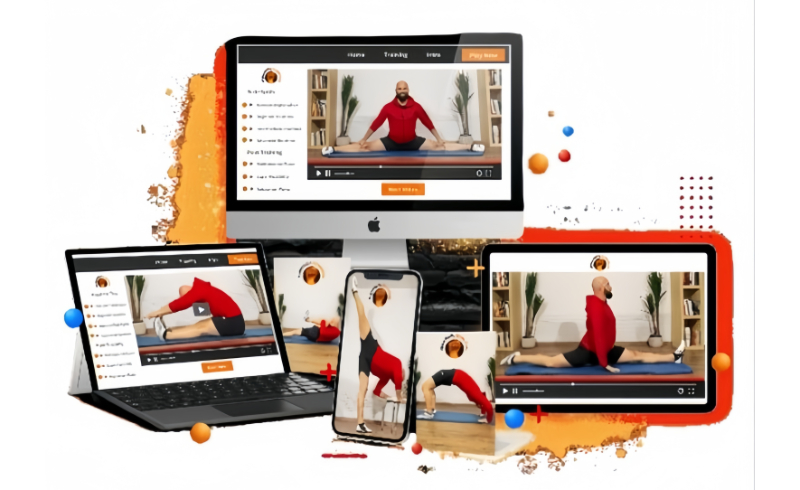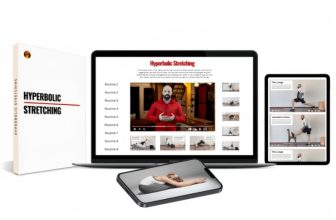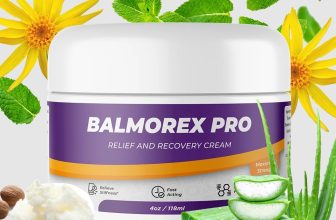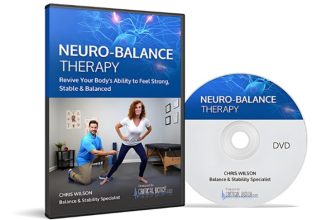Top exercises to improve flexibility with Hyperbolic Stretching.

About Hyperbolic Stretching
Hyperbolic Stretching is a method of stretching developed by Alex Larsson, a fitness and stretching expert. This method is designed to improve the flexibility of the body more quickly and effectively than traditional stretching methods.

According to Alex Larsson, Hyperbolic Stretching not only helps stretch the muscles but also affects the nervous system, making the body more flexible, increasing mobility and minimizing the risk of injury. This method is especially suitable for those who want to improve their flexibility to achieve difficult yoga postures, sports movements that require high flexibility or simply want a healthier body.
Hyperbolic Stretching combines static and dynamic stretching exercises, using special techniques to affect the muscles and major muscle groups of the body. This helps increase flexibility and coordination between muscles.
How it works
Hyperbolic Stretching works on the principle of “overcoming muscle limits”, which means you will stretch your body beyond its normal limits to achieve better flexibility. When performing stretching movements, your muscles will be continuously and gradually impacted, helping the muscle fibers to grow and lengthen.
The core of this method is the use of “active stretching” and “PNF stretching” (neuromuscular coordination stretching) techniques. Performing these exercises correctly will help improve flexibility quickly, without having to perform long or excessive stretching movements.
The important elements of Hyperbolic Stretching include:
Active stretching: Stretching is performed when you maintain active tension in the muscles, not simply passive stretching. This can help increase muscle length and flexibility.
Muscle-nerve coordination: Hyperbolic Stretching exercises combine the effects on the muscles and the nervous system. As the body gets used to stretching, the nerve reflexes help the body become more flexible.
Increase blood circulation: These stretching exercises help increase blood circulation to the muscles, helping the muscles recover faster after each workout.
Increase muscle strength: In addition to improving flexibility, this method also helps to increase muscle strength, which is especially important for people participating in sports that require high flexibility such as gymnastics, ballet, or yoga.

Benefits for flexibility
Improve flexibility quickly: One of the biggest benefits of Hyperbolic Stretching is its ability to improve the body’s flexibility in a short time. Typically, you can notice changes after just a few weeks of doing this method.
Reduce the risk of injury: When the body is more flexible, the muscles and joints can move in a wider range without experiencing tension or pain. This helps to reduce the risk of injury, especially during sports activities.
Improve overall body health: Hyperbolic Stretching not only improves flexibility but also helps to strengthen different muscle groups in the body. Regular exercise helps maintain body balance, reduce muscle fatigue, and improve muscle coordination.
Aids in weight loss: Hyperbolic Stretching exercises can help burn calories, especially when performed in a workout program that combines aerobic or resistance training.
Key Exercises in Hyperbolic Stretching
1. Inner Thigh Stretch
Goal: Increase flexibility in the inner thighs and hips.
Instructions:
- 1. Sit on the floor with your legs extended straight out.
- 2. Extend your legs toward your hips.
- 3. Grasp your toes or ankles with your hands, and slowly pull your body forward until you feel a stretch in your inner thighs.
- 4. Hold for 30 seconds and repeat 3 times.
• Benefits: Improves hip rotation and helps increase flexibility in the inner thigh muscles.
2. Hamstring Stretch
Goal: Increases flexibility in the hamstrings.
Instructions:
- 1. Lie on your back on the floor with one leg straight and the other bent.
- 2. Using a band or towel wrapped around the foot of the straight leg, slowly lift the leg up and pull it toward the body.
- 3. Try to keep the leg straight and feel the stretch in the hamstrings.
- 4. Hold for 30 seconds, repeat 3 times for each leg.
Benefits: Improves flexibility in the hamstrings, helping reduce the risk of injury during exercise.
3. Deep Hip Flexor Stretch
Goal: Increases flexibility in the hips and lower back.
Instructions:
- 1. Stand up straight and step one leg forward, bending the knee 90 degrees.
- 2. Place the other knee on the floor, keeping your back straight.
- 3. Push your hips forward to feel the stretch in your hips and lower back.
- 4. Hold for 30 seconds, switch legs and repeat.
Benefits: Improves hip flexibility and reduces lower back pain.

4. Glute Stretch
Goal: Increases flexibility in your glutes and hips.
Instructions:
- 1. Sit on the floor and place one foot on the opposite thigh so that your ankle touches the knee.
- 2. Slowly pull your leg up towards your chest, holding it with your hands.
- 3. Feel the stretch in your glutes and lower back.
- 4. Hold for 30 seconds, switch legs and repeat.
Benefits: Increases flexibility in your glutes and hips, reduces lower back pain.
5. Calf Stretch
Goal: Improve calf flexibility.
Instructions:
- Stand up straight and place one foot on a step or similar lift.
- Slowly push your hips forward while keeping your back leg straight.
- Feel the stretch in your calf and hold for 30 seconds.
- Repeat on the other leg.
Benefits: Increases calf flexibility, helping to reduce pain and muscle tension when running or exercising.
Notes when performing Hyperbolic Stretching
1. Warm up before exercising
An important element of Hyperbolic Stretching is to warm up thoroughly. Before performing stretching exercises, you need to warm up your body to avoid injury. Light warm-up exercises such as walking, jogging in place, or joint rotations can help prepare your body for stretching.
2. Maintain proper posture
Make sure you perform the correct posture throughout the exercise to avoid straining muscles or injuring joints. It is important to keep your back straight, control your breathing, and not rush through each stretch.
3. Maintain and be patient
Hyperbolic Stretching requires patience and regular maintenance over a long period of time to see results. The exercises need to be performed every day or at least 3-4 times a week to achieve the desired flexibility.

Conclusion
The Hyperbolic Stretching method is a great option to improve your body’s flexibility quickly and effectively. With exercises specifically designed to increase flexibility for each muscle group, this method helps you minimize injuries, improve posture, and improve overall health.
If you want to achieve superior flexibility, be persistent in performing Hyperbolic Stretching exercises every day and pay attention to the principles of correct technique.











